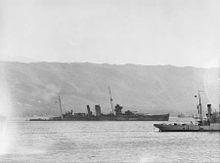Torpedo men attack
| Movie | |
|---|---|
| German title | Torpedo men attack |
| Original title | Siluri umani |
| Country of production | Italy |
| original language | Italian |
| Publishing year | 1954 |
| length | 98 minutes |
| Rod | |
| Director |
Antonio Leonviola Carlo Lizzani |
| script |
Marcantonio Bragadin Ennio De Concini Giangiacomo Crossa |
| production |
Carlo Ponti Dino De Laurentiis |
| music | Angelo Francesco Lavagnino |
| camera | Riccardo Pallottini |
| cut | Renato Cinquini |
| occupation | |
| |
Torpedo men attack ( Italian original title Siluri umani = human torpedoes ) is an Italian war film from 1954, which is set in Crete during the Second World War in 1941 . The role of the marine diver and speedboat driver Magrini was played by Carlo Pedersoli, who later became internationally known under the stage name Bud Spencer . Other performance titles are Tscheweschki Torpeda ( Bulgaria ), Torpedos Humanos ( Brazil , Portugal ), Uppdrag utan återvändo ( Sweden ), Torpilles humaines ( France ), Menneske-torpedoer ( Denmark ). The film was made in close cooperation with the Marina Militare with the special participation of frigate captain Luigi Faggioni . The West German premiere took place on April 27, 1956.
action
Italy probably at the end of 1940. Several officers and non-commissioned officers of the Italian Navy meet at a naval base upon invitation. Here it is explained to them that a special company against the Royal Navy is planned in Crete, for which highly qualified personnel is required. All volunteer.
In a specially prepared exercise area, the volunteers train the use of miniature torpedo boats or speedboats of the type explosive boat MT against the British. The boats only carry one torpedo . The tactic is to sneak up on the enemy ships at night and then approach the target at top speed. Shortly before the collision, the speedboat drivers wearing diving suits are supposed to jump backwards from the boats. It is expected that the British will then rescue the shipwrecked voluntarily. As the training officer points out, it is not a kamikaze company.
The unit is relocated to the Greek island of Leros . But before the operation against Crete takes place, an emergency arises. An Italian submarine is attacked and sunk by two British fighter bombers . However, since the wreck lies in shallow waters, it is possible to rescue part of the crew who are in an area of the boat separated by bulkheads. In a highly dramatic rescue operation, the members of the command succeed in first laying an oxygen line in the submarine and then opening a hatch so that the crew, who are extremely nervous, can finally get out of the sunken wreck and be rescued.
Then the command attacks the Sudabucht at night. With great difficulty it is possible to overcome sea mine barriers. Although they are discovered by the British guards and taken under raging fire, the attack on the British units succeeds. The torpedo men who jumped off in time were rescued by the British and were taken prisoner of war .
Production notes, historical background
The film reconstructs the attack by small torpedo boats of the Decima Flottiglia MAS on 25/26. March 1941 in the Suda Bay on Crete against units of the Royal Navy, in which the heavy cruiser HMS York was sunk. At the time of the action, the use of Japanese kamikaze pilots had not yet taken place, the cinematic reference to it is therefore unhistorical.
The production was made in the spring of 1954 in collaboration with Admiral Bragadin, who is portrayed in the film by Emilio Cigoli. The adviser Luigi Faggioni was the commanding officer of the operation. Bragadin was also involved in the scripts for the war films The Seven of the Big Bear , El Alamein and Trapped in the Deep . What they all have in common is that they were created in close cooperation with the Italian armed forces. The political level is completely hidden, there is no reference to the fascist system of rule.
Since director Leonviola stopped the shooting shortly before completion, it was ended by Carlo Lizzani.
literature
- Giacomo Lichtner: Fascism in Italian cinema since 1945. The politics and aesthetics of memory , Basingstoke u. a. (Palgrave Macmillan) 2013. ISBN 978-0-230-36332-8
